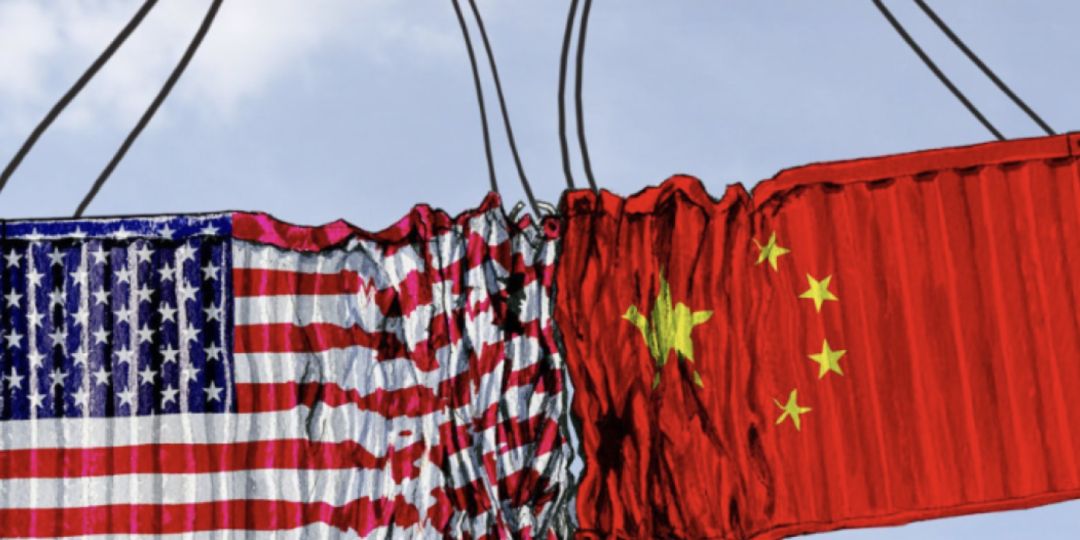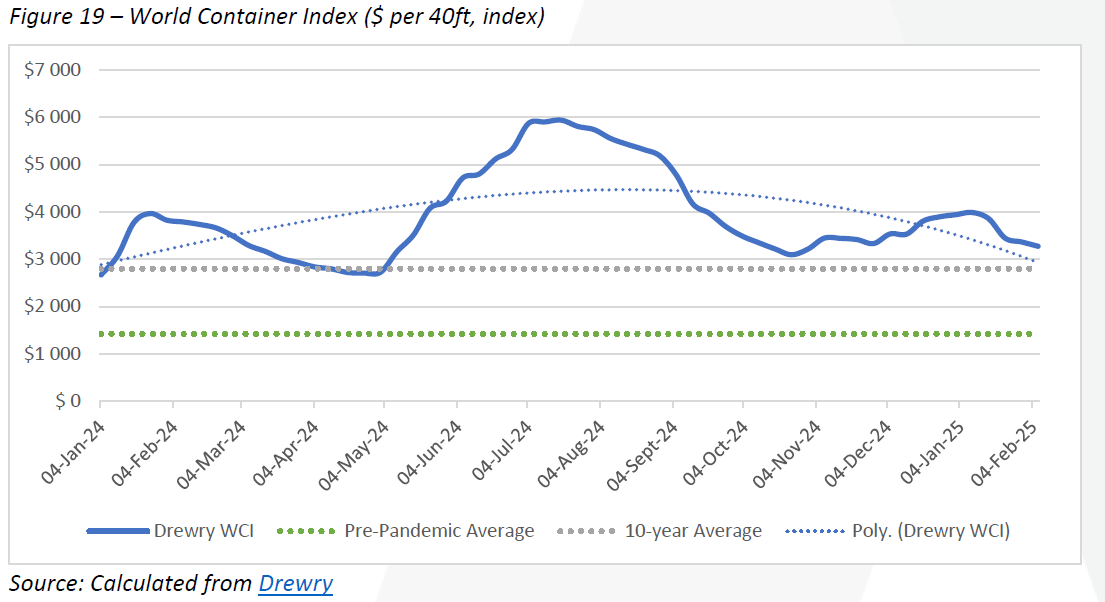Welcome to another Logistics News Update.
There’s a lot happening in global trade, particularly between the U.S. and South Africa’s biggest trading partner, China. But what does this mean for us here in South Africa? Let’s take a closer look at what’s unfolded so far.
On February 4, 2025, President Donald Trump implemented a 10% tariff on all Chinese imports, intensifying trade tensions between the United States and China. In response, China imposed retaliatory tariffs on the 10th of February 2025, including a 15% levy on U.S. coal and liquefied natural gas, and a 10% tariff on crude oil, agricultural machinery, and large vehicles. Additionally, China initiated an antitrust investigation into Google and imposed export controls on certain metals. Despite these escalating measures, President Trump has expressed no immediate intention to engage in discussions with Chinese President Xi Jinping to de-escalate the situation. Source: Reuters.
How U.S.-China Trade War Affects South Africa
The U.S. has imposed new 10% tariffs on all Chinese imports, escalating a years-long trade war. China retaliated by targeting American energy and agricultural exports, including 25% tariffs on U.S. LNG and coal. For South Africa, this could mean:
Possible Opportunities
- Export Boost: China may turn to SA for coal, platinum, and citrus as it pivots from U.S. suppliers. (SA already supplies 60% of China’s manganese—key for steel production.)
- BRICS Advantage: SA could leverage partnerships with China/Russia to secure trade deals or investment in manufacturing.
⚠️Risks
- ⚠️ Cost Pressures: SA businesses reliant on Chinese machinery (40% of SA’s imports) face pricier inputs, squeeing margins.
- ⚠️ Rand Turbulence: Global risk aversion could weaken the Rand, raising fuel and import costs amid SA’s inflation struggles.
- ⚠️Logistics & Supply Chains: Shipping costs and delays could increase due to trade disruptions.
The Bottom Line: While SA may gain short-term export wins, long-term gains depend on fixing local bottlenecks (ports, power) to capitalise on supply chain shifts. Businesses should diversify suppliers, lock in forex rates, and explore BRICS-aligned trade channels.
Let’s Learn
This Week’s Learning Spotlight: Sometimes, we assume we know it all—but even experienced importers and exporters can overlook the basics. Here’s a quick refresher to ensure your EXPORT process runs smoothly:
Requirements to Clear Customs When Exporting Goods into South Africa
| 1. Essential Documentation Commercial Invoice – Includes buyer & seller details, product descriptions, HS codes, value, and incoterms. Packing List – Specifies itemised shipment details, including weight and dimensions. Bill of Lading / Airway Bill – Issued by the carrier, confirming the shipment’s transport details. Customs Declaration (SARS SAD 500 Form) – Required for all exports. Certificate of Origin – Needed for preferential trade agreements (e.g., SADC, AGOA, EU Trade Agreements). Export Permits (If Required) – Certain goods (e.g., restricted minerals, arms, agricultural products) require pre-approval. Letter of Credit or Payment Documents – Ensure the payment method (L/C, TT, CAD) aligns with buyer agreements. Insurance Certificate – Recommended for high-value or high-risk shipments. 2. Duties and Taxes HS Code Classification – Correct tariff codes to qualify for trade benefits or preferential duty rates. VAT Zero-Rating Compliance – Ensure proper VAT treatment for exported goods. Duty Drawbacks & Incentives – Check eligibility for export rebates or duty drawback schemes. Preferential Trade Agreements – Utilise agreements like SADC, AGOA, and EU-SADC EPA for tariff reductions. | 3. Logistics & Shipping Considerations Freight Booking – Confirm space with shipping lines, airlines, or road transporters. Incoterms Compliance – Ensure clarity on cost, risk, and responsibility (e.g., EXW, FOB, CIF, DAP). Customs Broker / Freight Forwarder – Appoint a licensed clearing agent if needed. Pre-Shipment Inspections (If Required) – Some buyers require third-party inspections before shipping. Export Packaging & Labelling Compliance – Ensure adherence to international packaging standards. Fumigation (if Required) – ensure that you use Eco Friendly Profume 4. Post-Shipment Compliance & Documentation Proof of Export (Export Declaration & Transport Docs) – Required for SARS VAT zero-rating audits. Record-Keeping – Maintain export records for at least five years for compliance purposes. Foreign Exchange Reporting – Submit forex documents to the bank for Reserve Bank compliance. Customs Compliance Audits – Stay prepared for periodic SARS or Reserve Bank checks. 5. Final Tips for a Smooth Export Process Work with a us your trusted logistics provider to avoid delays. Stay updated on international trade regulations for your target markets. Ensure all documentation is accurate to prevent customs rejections or payment delays. Negotiate clear payment terms with buyers to avoid financial risk. By following this export checklist, businesses can optimise trade efficiency, ensure regulatory compliance, and expand into global markets. |
*This is a high level and may change due to the nature of your goods and country you are exporting to
NEWS
USPS backtracks in China de minimis decision
07th Feb 2025 – Staff Reporter

Source: Tariff spat
The United States Postal Service (USPS) has swiftly reversed its decision to halt inbound parcels from China and Hong Kong, confirming that it will continue to accept shipments despite initial concerns over new tariff regulations. This comes as other logistics operators reportedly suspend their services to the U.S., following heightened trade restrictions. The USPS, in collaboration with U.S. Customs and Border Protection, is working to ensure a smooth implementation of new China tariffs with minimal disruption to package delivery.
This development coincides with the Trump administration’s move to revoke the Section 321 de minimis exemption for goods under $800, a policy shift that could significantly impact e-commerce businesses relying on direct-from-China fulfilment models such as Temu and Shein. Analysts have raised concerns about whether U.S. Customs can handle the increased volume of shipments requiring formal entry, especially given the scale of de minimis trade, which saw four million shipments processed daily in 2023.
While Mexico and Canada were initially affected by the removal of their de minimis access, a later policy reversal provided relief, preserving their ability to ship small-value goods duty-free. However, China remains the primary target of these changes, and industry experts suggest Chinese e-commerce firms may have anticipated this move. With nearly 2.5 million additional shipments now requiring formal customs clearance, pressure is mounting on the U.S. logistics infrastructure to adapt swiftly…
– Adapted from Source: FreightNews
State of Sars’ EDI platform is a concern
06 Feb 2025 – Staff Reporter

Since October 2024, the South African Revenue Service (SARS) Electronic Data Interchange (EDI) platform has been experiencing persistent delays in processing customs declarations. Initially, these delays were minimal and sporadic, only causing slight disruptions in shipment releases for both air and sea freight. However, over the past few months, the frequency and duration of these delays have increased significantly, with response times stretching from mere minutes to several hours.
Under normal conditions, the SARS EDI system processes release messages within seven seconds, making any prolonged delay a major concern for supply chain efficiency. The growing backlog of customs clearance responses has impacted logistics operations, slowing down trade and adding to industry frustrations. These inefficiencies have been observed consistently through November, December, and January, making delays the new norm rather than an isolated issue.
With no immediate resolution in sight, businesses reliant on seamless customs clearance face operational disruptions, potentially increasing costs, and shipment backlogs. The industry is calling for urgent intervention to restore the efficiency of SARS’ EDI system, as prolonged delays could have broader economic consequences, affecting trade flows and supply chain reliability across South Africa...
– Adapted from Source: FreighNews
WEEKLY NEWS SNAPSHOT
- SA-US trade relations walk a tightrope: President Ramaphosa has reaffirmed South Africa’s commitment to its foreign policy, rejecting external pressures that could affect trade relations with the United States.
- African countries make strides on net-zero journey: A recent workshop identified actionable steps to enhance the implementation of the International Maritime Organisation’s treaty regulating ship emissions.
- Cathay Cargo adopts new IATA data protocol: Cathay Cargo has implemented a new International Air Transport Association data protocol, providing shippers, freight forwarders, and other supply chain stakeholders with information such as cargo location and temperature.
- Global services trade soars: Digitally deliverable services, including computer, financial, business, and insurance services, have been the main drivers of growth in global services trade.
- Several factors influence demand for C&F services: Leading value-added sectors are under pressure, posing risks for clearing and forwarding agents dependent on these industries.
- OPINION: R940-billion infrastructure push hinges on key dynamics: President Ramaphosa’s commitment to infrastructure investment presents an opportunity to develop a more functional and efficient public infrastructure network.
- Transnet publishes tariff proposal for rail operators: Transnet has released a tariff proposal for rail operators and invited stakeholders to provide feedback, noting that the document may still be updated.
Port Operations Summary: – Port Update:
Maersk send out a warning for Cape Town: Please note that as per latest weather forecasts, strong winds are expected in Cape Town over the coming weekend. We expect no operations to happen in the Cape Town Container Terminal (CTCT) over this period. We are working proactively with the terminal to align stacks based on these stoppages.
Durban : The port has experienced low wind speeds during the week.
- Pier 1 : Significant improvement going into 2025. No waiting time: productivity target met.
- Pier 2 : Significant improvement going into 2025. Max 0-2 days waiting time; productivity close to target.
- Durban Point : 3 days delay
Cape Town: The port has experienced strong winds during the week.
- CTCT : 0-1 day waiting time, limited wind delays, services on schedule.
- MPT : No waiting time, limited wind delays, services on schedule.
Port Elizabeth (Gqeberha): The port has experienced windy weather during the week.
PECT : No waiting time, some wind delays. Terminal maintenance planned.
NCT : No Waiting time, some wind delays, services on schedule. Source: SACO
BUSA Cargo Movement Update – 12 February 2025
South Africa’s Weekly Logistics & Trade Update
Port & Shipping Overview
South African ports handled an average of 10 938 TEUs per day, a 5% decline from last week. Operations were constrained by bad weather, vacant berths, and equipment breakdowns.
- Cape Town lost over 30 operational hours due to strong winds.
- Durban continued to struggle with adverse weather and ongoing equipment failures.
- Eastern Cape ports were affected by vacant berths and bad weather, while Richards Bay saw minimal delays.
On the global front, container volumes increased by 4.5% month-on-month and 7.6% year-on-year, with Sub-Saharan African exports rising by 13.4%. However, South Africa’s share of regional trade is declining, underscoring the urgent need for logistics reform. The Red Sea crisis persists, forcing most major carriers to reroute via the Cape of Good Hope until at least March, adding pressure on local ports.
Freight & Contract Rates
- Global container spot rates declined 2.7% this week, now averaging $3 273 per 40-ft container.
- Despite the drop, rates are still 130% above pre-pandemic levels.
- Charter rates remain high, with Maersk paying $100 000 per day to secure scarce vessels.
Air Cargo Update
Air cargo volumes at OR Tambo International Airport (ORTIA) recorded significant outbound growth:
- Inbound cargo: 507 356 kg (↓5% week-on-week).
- Outbound cargo: 548 231 kg (↑51% week-on-week).
- The total January volume was up by 34% year-on-year, indicating strong demand.
Global air cargo saw a 2% year-on-year increase in January, but growth has slowed compared to 2024’s 11% rise. Additionally, President Trump’s new trade policies have suspended duty-free imports from China, Canada, and Mexico, which could disrupt global e-commerce supply chains.
Border & Rail Operations
- Truck volumes at the Lebombo Border Post increased slightly to 1 453 HGVs per day.
- South African border crossing times increased to 12.2 hours (↑14% week-on-week).
- Cross-border queues decreased by 1.2 hours, while SADC median border crossing times remained at 5.8 hours.
- A derailment on the ConCor rail line near Pretoria impacted freight movement.
Industry Outlook & Policy Concerns
Following the State of the Nation Address (SONA), logistics challenges remain. While the Freight Logistics Roadmap aims to improve efficiency, progress is slow. Open rail access is a milestone, but implementation has been sluggish. Port equipment upgrades and private sector participation are promising but need to move from discussion to execution.
The key message: Government and industry must prioritise rapid, accountable implementation of logistics reforms. The time for delays is over—measurable results must be delivered now.
Summary of Global Shipping Industry
International Trade & Logistics Update
Global Shipping Industry
- US Tariffs & Trade Impact : The United States is set to introduce new tariffs from 4 February 2025, imposing 25% duties on imports from Canada and Mexico, along with an additional 10% tariff on imports from China. These measures are expected to worsen the already imbalanced US container trade, where imports have consistently outpaced exports (2.4:1 in 2024). Despite previous tariffs, China remains the dominant supplier, accounting for 41% of US containerised imports. The new tariffs are unlikely to change this trend significantly, though businesses are advised to remain flexible and strategically plan for potential trade shifts.
- Global Shipping Schedule Reliability: According to Sea-Intelligence’s Global Liner Performance (GLP) report, schedule reliability remained volatile throughout 2024, averaging between 50%-55%. December saw a slight decline to 53.8%, down 3% year-on-year. The average delay for late vessel arrivals improved to 5.28 days, the lowest since July 2024. Among major carriers, Maersk led with 60.4% reliability, while Wan Hai had the lowest at 47.9%. Port congestion eased slightly this week, with 2.83 million TEU still stuck in the system—down from 3.3 million last week. However, congestion persists in China due to the Lunar New Year, while severe weather in the US Atlantic and English Channel continues to disrupt schedules.
- Freight & Contract Rates: Global container spot rates declined again this week, dropping by 2.4% to $3 364 per 40-ft container. Spot rates are now 12% lower than this time last year but remain 137% above the pre-pandemic average of $1 420 in 2019. Despite the general decline, rates on the Shanghai-Durban route remain high at $6 810 per 40-ft container due to blank sailings and a focus on European trade lanes. South Africa typically experiences market shifts a month or two later, suggesting further adjustments ahead. Meanwhile, charter rates remain stable, with the Harpex Index at 2 057 points—94% higher than a year ago.
- Outlook for Shippers: With ongoing market volatility and trade uncertainty, businesses are advised to adopt a flexible and strategic approach. This includes adjusting product sourcing, rebalancing supply chains, and exploring new markets. Analysts recommend focusing on long-term resilience rather than reactive changes, as the trade environment remains unpredictable.
- Source: BUSA
Global Container Freight Rates
Global freight and contract rates
Global container spot rates have cooled again this week, as rates dropped by ↓2,7% this week to $3 273 per 40-ft container13, according to Drewry’s “World Container Index“. Spot rates are ↓14% less than this time last year (but still ↑130% above the average pre-pandemic level of $1 420 in 2019. The following illustration shows the changes since the start of last year:

Meanwhile, charter rates have remained stable (but still elevated), as the Harper Petersen Index (Harpex) traded around 2 058 points (↑88%, y/y) on Friday. Indeed, the strength of the charter market is evident, as Maersk is paying $100 000 a day to charter scarce post-panamax box ships.14
iv. Further developments of note
- Apart from the overview provided above, there were some additional noteworthy developments this week:
- Panama Canal update amidst US pressure: Panama has decided not to renew its Belt and Road Initiative (BRI) agreement with China. It is considering cancelling a port concession with Hong Kong-based Hutchison Port Holdings due to US concerns over Chinese influence.15
- Additionally, President Jose Raul Mulino has tightened migration controls, positioning Panama as the US’s new southern border. However, he has resisted pressure to relinquish control of the Panama Canal.
Source: BUSA
This week’s news was brought to you by:
FNB First Trade 360 – a digital logistics platform and Exporters Western Cape
“This information contained herein is being made available for indicative purposes only and does not purport to be comprehensive as the information may have been obtained from publicly available sources that have not been verified by FirstRand Bank Limited (“FRB”) or any other person. No representation or warranty, express, implied or by omission, is or will be given by FRB, its affiliates or their respective directors, officers, employees, agents, advisers, representatives or any other person as to the adequacy, reasonableness, accuracy or completeness of this information. No responsibility or liability is accepted for the accuracy or sufficiency thereof, or for any errors, omissions or misstatements, negligent or otherwise, relating thereto. In particular, but without limitation, no representation or warranty, express or implied, is given as to the achievement or reasonableness of, and no reliance should be placed on, any projections, targets, estimates or forecasts and nothing contained herein should be, relied on as a promise or representation as to the past or future. FRB does not undertake any obligation to provide any additional information or to update the information contained herein or to correct any inaccuracies that may become apparent. The receipt of this information by any person is not to be taken as constituting the giving of any advice by FRB to any such person, nor to constitute such person a client of FRB.”



